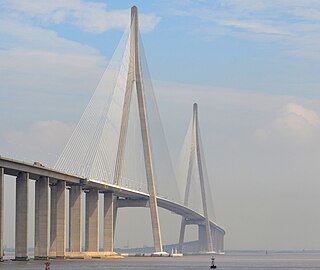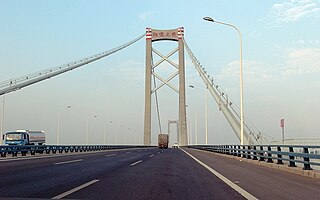
A cable-stayed bridge has one or more towers, from which cables support the bridge deck. A distinctive feature are the cables or stays, which run directly from the tower to the deck, normally forming a fan-like pattern or a series of parallel lines. This is in contrast to the modern suspension bridge, where the cables supporting the deck are suspended vertically from the main cable, anchored at both ends of the bridge and running between the towers. The cable-stayed bridge is optimal for spans longer than cantilever bridges and shorter than suspension bridges. This is the range within which cantilever bridges would rapidly grow heavier, and suspension bridge cabling would be more costly.

The Runyang Yangtze River Bridge is a large bridge complex that crosses the Yangtze River in Jiangsu Province, China, downstream of Nanjing. The complex consists of two major bridges that link Zhenjiang on the south bank of the river and Yangzhou on the north. The bridge is part of the Yangzhou–Liyang Expressway. Construction of the bridge complex began in October 2000 and was completed ahead of schedule. The bridge cost 5.8 billion Yuan. The complex opened to traffic on April 30, 2005. The total length of the bridge complex is about 35.66 kilometres (22.16 mi). In between the two bridges is the island of Shiyezhou.

An extradosed bridge employs a structure that combines the main elements of both a prestressed box girder bridge and a cable-stayed bridge. The name comes from the word extrados, the exterior or upper curve of an arch, and refers to how the "stay cables" on an extradosed bridge are not considered as such in the design, but are instead treated as external prestressing tendons deviating upward from the deck. In this concept, they remain part of the main bridge superstructure.
The Yangtze River power line crossings are overhead power lines that cross the Yangtze River in China. There are at least three power line crossings on the Yangtze River at Jiangyin, Nanjing, and Wuhu. The towers of the crossing in Jiangyin are among the highest in the world.

The Sutong Yangtze Bridge is a cable-stayed bridge that spans the Yangtze in China between Nantong and Changshu, a satellite city of Suzhou, in Jiangsu province.

The Sidu River Bridge is a 1,222 m-long (4,009 ft) suspension bridge crossing the valley of the Sidu River near Yesanguan in Badong County of the Hubei Province of the People's Republic of China. The bridge was designed by CCSHCC Second Highway Consultants Company, Limited. and built at a cost of 720 million yuan. It opened to traffic on November 15, 2009.

The bridges and tunnels across the Yangtze River carry rail and road traffic across China's longest and largest river and form a vital part of the country's transportation infrastructure. The river bisects China proper from west to east, and every major north–south bound highway and railway must cross the Yangtze. Large urban centers along the river such as Chongqing, Wuhan, and Nanjing also have urban mass transit rail lines crossing the Yangtze.

The Chaotianmen Bridge, is a road-rail bridge over the Yangtze River in the city of Chongqing, China. The bridge, which opened on 29 April 2009, is the world's longest through arch bridge.

The Jiangyin Yangtze River Bridge is a suspension bridge over the Yangtze River in Jiangsu, China. The bridge has a main span of 1,385 metres (4,544 ft) connects Jiangyin south of the river to Jingjiang to the north. When the bridge was completed in 1999, it was the fourth longest suspension bridge span in the world and the longest in China. Several longer bridges have since been completed in China and abroad, and it is currently the 15th longest suspension bridge in the world. The bridge was also the furthest downstream on the Yangtze until the completion of the Sutong Yangtze River Bridge in 2008 and the Chongming–Qidong Yangtze River Bridge in 2011.

The Yangluo Yangtze River Bridge is a suspension bridge over the Yangtze River in Wuhan, Hubei, China. With a main span of 1,280 metres (4,200 ft), at its opening it was tied with the Golden Gate Bridge as the ninth longest suspension bridge in the world. The bridge carries the G70 Fuzhou–Yinchuan Expressway and G4201 Wuhan Ring Expressway over the Yangtze River and provides easy access to both sides of the river as part of a larger plan to promote development in the eastern portion of the city. Construction on the bridge began on November 4, 2003, and it opened to traffic on December 26, 2007.

The Nanjing Dashengguan Yangtze River Bridge, formerly Third Nanjing Yangtze Bridge, is the first cable-stayed bridge with steel tower stanchions located in Nanjing, China. It is the third crossing of the Yangtze River at Nanjing. The cable-stayed portion is just a part of the 4.7 kilometers of the complete bridge. Constructed in slightly more than two years at a cost of $490 million, this bridge features dual 215 meters towers. The main span measures 648 meters. When it was completed in 2005 it was the third longest cable stayed span in the world. It still ranks among the top 20. The bridge carries the G42 Shanghai–Chengdu Expressway and the G2503 Nanjing Ring Expressway. The bridge has renamed on 20 December 2019.

The Taizhou Yangtze River Bridge is a bridge complex over the Lower Yangtze River in Jiangsu Province in eastern China. The bridge connects Taizhou on the north bank, Yangzhong on an island in the river, and Yaoqiao Village of Zhenjiang Municipality on the south bank, and consists of a suspension bridge across the north branch stream and a pair of box-girder bridges across the south branch stream. Taizhou Bridge Complex opened in 2012.

The 1915 Çanakkale Bridge is a road suspension bridge in the province of Çanakkale in northwestern Turkey. Situated just south of the coastal towns of Lapseki and Gelibolu, the bridge spans the Dardanelles, about 10 km (6.2 mi) south of the Sea of Marmara. The bridge was officially opened by President Recep Tayyip Erdoğan on 18 March 2022 after roughly five years of construction. The year "1915" in the official Turkish name honours an important Ottoman naval victory against the navies of the United Kingdom and France during World War I.

The Yangsigang Yangtze River Bridge is a suspension bridge in Wuhan, Hubei, China. It opened to traffic on October 8, 2019 and is the third longest suspension bridge span in the world and overall the longest in China. The bridge spans 1,700 metres across the Yangtze River. The bridge is the longest double-deck bridge span in the world and carries motorized vehicles, non-motorized vehicles, and pedestrians on its two decks. The bridge cost CNY ¥8.5 billion to build.
The Wufengshan Yangtze River Bridge is a two-decked suspension bridge carrying the Lianyungang–Zhenjiang high-speed railway and the Jiangyi Expressway over the Yangtze. With a total length of 6,409 m (21,027 ft) and a main span of 1,092 m (3,583 ft), it is the world's longest span high-speed railway bridge, tied with the Hutong Yangtze River Bridge.
Oujiang Beikou Bridge is a suspension bridge between Yueqing and Dongtou District, Wenzhou City, in Zhejiang Province, China. It is an important part of the Yongguan Expressway and China National Highway 228. It is the world's first three-tower four-span double-decked steel truss suspension bridge. The construction cost was 8.836 billion yuan, and construction started on 30 November 2016. The main bridge was finished on 30 December 2021, and the upper floor was opened to traffic on 27 May 2022,lower floor was opened to traffic on 31 August 2022.














